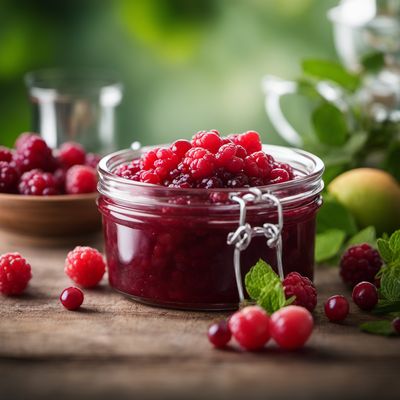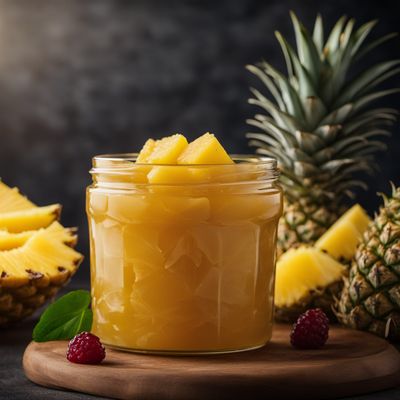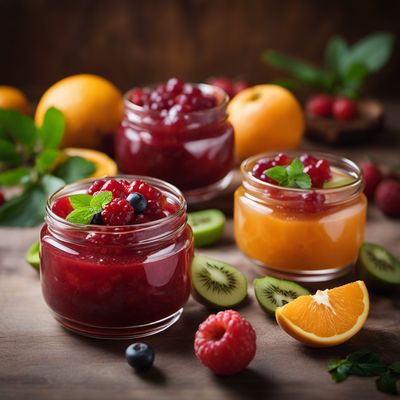
Ingredient
Compote of fruit / vegetables
Sweet and Tangy Medley
Compote of fruit/vegetables is a luscious blend of fruits or vegetables that have been gently simmered with sugar, water, and aromatic spices. It has a soft and tender texture, with the fruits or vegetables breaking down slightly during the cooking process. The appearance of compote can vary depending on the ingredients used, but it often showcases vibrant colors and a glossy finish.
Origins and history
The tradition of making compote dates back centuries, with variations found in different cultures around the world. It was a popular method of preserving fruits and vegetables before the advent of modern canning techniques. Compote is often associated with European cuisine, where it is enjoyed as a dessert or used as a filling for pastries.
Nutritional information
Compote of fruit/vegetables is a source of vitamins, minerals, and dietary fiber. The nutritional content can vary depending on the specific fruits or vegetables used and the amount of added sugar. It is generally lower in calories compared to other sweetened desserts or preserves.
How to select
When selecting compote of fruit/vegetables, look for jars or containers that are tightly sealed and free from signs of spoilage, such as mold or fermentation. Check the ingredient list to ensure that it contains high-quality fruits or vegetables and minimal additives or preservatives. Homemade compote can also be prepared using fresh, ripe produce and customized to suit personal preferences.
Storage recommendations
To maintain the freshness and quality of compote, store it in airtight containers in the refrigerator. Properly stored compote can last for several weeks. It is important to avoid cross-contamination by using clean utensils when serving or scooping out portions of compote.
How to produce
Producing compote of fruit/vegetables at home is a straightforward process that involves cooking fruits or vegetables with sugar, water, and spices until they soften and release their juices. It can be made in small batches using a stovetop method or in larger quantities using a slow cooker or pressure cooker. Experiment with different combinations of fruits or vegetables and spices to create unique flavor profiles.
Preparation tips
Compote of fruit/vegetables can be enjoyed on its own as a simple and refreshing dessert. It can also be used as a topping for pancakes, waffles, yogurt, ice cream, or oatmeal. Additionally, compote can be incorporated into baked goods, such as cakes, tarts, or muffins, to add a burst of flavor and moisture.
Culinary uses
Compote of fruit/vegetables is commonly used in desserts and pastries, such as fruit tarts, crumbles, pies, and parfaits. It is also a versatile ingredient in breakfast dishes, like French toast, crepes, or porridge. In savory applications, compote can be paired with cheese, served alongside roasted meats, or used as a glaze for grilled vegetables.
Availability
Compote of fruit/vegetables is commonly available in grocery stores, specialty food stores, and farmers markets. It can also be made at home using fresh or frozen fruits or vegetables.
More ingredients from this category » Browse all

Fruit compote, table grape
Versatile Sweet Medley

Fruit compote, apricot
Apricot Delight

Fruit compote, peach
Peachy Delight

Fruit compote, cranberry
Tangy and Sweet Cranberry Delight

Fruit compote, pineapple
Tropical Delight: Exploring the Sweet and Tangy Pineapple Fruit Compote

Fruit compote, mixed fruit
A Symphony of Sweetness: Exploring the Delights of Mixed Fruit Compote

Fruit compote, sour cherry
Tangy Delight: Exploring the World of Sour Cherry Fruit Compote

Fruit compote, pear
Pearlicious Delight

Fruit compote, apple
Apple Delight: Exploring the Versatility of Fruit Compote

Fruit compote, mandarin
Tangy Delight: Exploring the Zesty Mandarin Fruit Compote

Fruit compote, plum
Plum Delight: Exploring the Sweet and Tangy World of Fruit Compote

Fruit compote, sweet cherry
A Symphony of Sweetness: Exploring the Delights of Sweet Cherry Fruit Compote
Recipes using Compote of fruit / vegetables

Argentinian Pastafrola
Tango Tart: A Sweet Symphony of Argentinian Flavors

British Berry Delight Parfait
Berrylicious Summer Parfait: A British Twist on a French Classic

Homemade Italian Country Gelato
Rustic Delights: A Taste of Italian Country Gelato

Mazurek - Traditional Polish Easter Pastry
Easter Delight: A Sweet Symphony of Mazurek